What is Micro Investing (Is It Worth It?)
Investing is the key to building long-term wealth. You can invest in all kinds of assets: stocks, bonds, mutual funds, real estate, you name it.
Learning how to invest, however, is a bit difficult.
On top of that, investing has historically been reserved for those with money in the first place. You needed to pay a broker to buy assets for you, maintain large minimum balances in your investment accounts, and in the case of securitized assets like stocks, you couldn’t just buy fractional shares.
But the traditional barriers to investing are dead. Nowadays, there are tons of apps and websites where you can sign up and start investing in minutes without needing $10,000 just to keep your account open.
Introducing micro investing!
What is Micro Investing?
Micro investing is quite literally investing on a much smaller scale. You deposit small amounts of money into an investment account in order to buy assets affordably.
In the case of stocks, most micro investing services let you buy fractional shares.
Micro investing apps each have different methods of micro investing. Some “round up” your spare change from everyday purchases and invest it. Others let you choose your investments based on a variety of criteria such as what you believe in (such as a human rights cause) or what you’re personally interested in (such as social media).
Still others have 0 fees of any sort to encourage those without a lot of money to start investing.
Now, micro investing itself won’t make your rich, but it’s a great first step into the investing world.
Like they say, the best time to start investing was yesterday and the 2nd best time is today.
Who Should Start Micro Investing
Micro-investing is best for beginners and younger investors. And yes, you can be both of those at once.
Beginners will find it useful because you aren’t risking significant amounts of money.
People with a lot of investing knowledge and experience can try micro investing, but they could easily use their skills to earn a better return through normal investing.
As for those who just have a ton of money, they should skip the micro investing completely. If that sounds like you, you can hire a financial advisor to manage your investments for you instead. You’ll never need to teach yourself investing if you don’t want to.
The Best Micro Investing Apps
Here we have the best micro investing apps. Each one has something different to offer, so weigh the features of each carefully before picking one!
Acorns
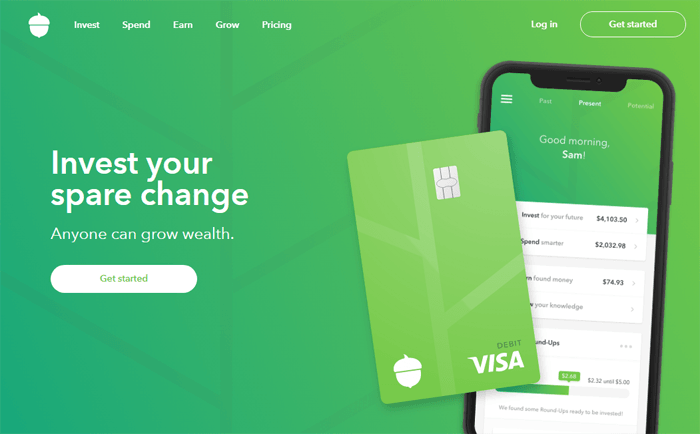
Acorns is an extremely popular micro investing app. It combines automatic savings with the power of robo-advisors to offer a simple yet rewarding way to invest without needing a lot of money.
Acorns requires no minimum deposit; you can open an account for free. All you need is $5 to start investing once your account is up and running.
They only offer 5 prebuilt portfolios, so you don’t have a lot of options for investing.
But at the same time, limited options mean this a great app for absolute beginners. Acorns supplements their beginner-friendly investing model with education content on their site, as well as their millennial-focused personal finance site called Grow Magazine.
Acorns unfortunately does have quite high management fees for an investing app. That’s the cost of the convenience of round-ups, though.
Round-Ups
Acorns is most well-known for their “round-up” feature, which allows you to link credit cards or bank accounts and automatically invest spare change from purchases made with your linked accounts by drawing on your checking account.
For example, let’s say you buy $30.85 in gas with your linked credit card. Acorns will then charge your linked checking account for $0.15 cents (the amount needed to reach the next whole dollar, $31) and invest it into your account.
You can disable the automatic round-ups as well if you prefer manually approving each round-up.
Found Money
Investing your spare change just wasn’t enough for Acorns; they’ve partnered with almost 400 companies, including big names like Apple and Amazon, to offer you cash back for shopping.
All you do is use your linked car when shopping with on of their partners and Acorns will credit your investment account with cash back.
Fee-Free For College Students
Broke college students rejoice! Acorns charges $0 management fees for up to 4 years if you register using your .edu email address. That way, you can start your investing early even if you’re living on ramen every day.
Using the round-up feature, you can build your wealth on a college budget. Whether you’re buying textbooks for class or drinks after finals, you’ll get 4 full years of tiny roundups.
Once you cross that stage at graduation, you’ll have a head start on building your wealth!
Betterment
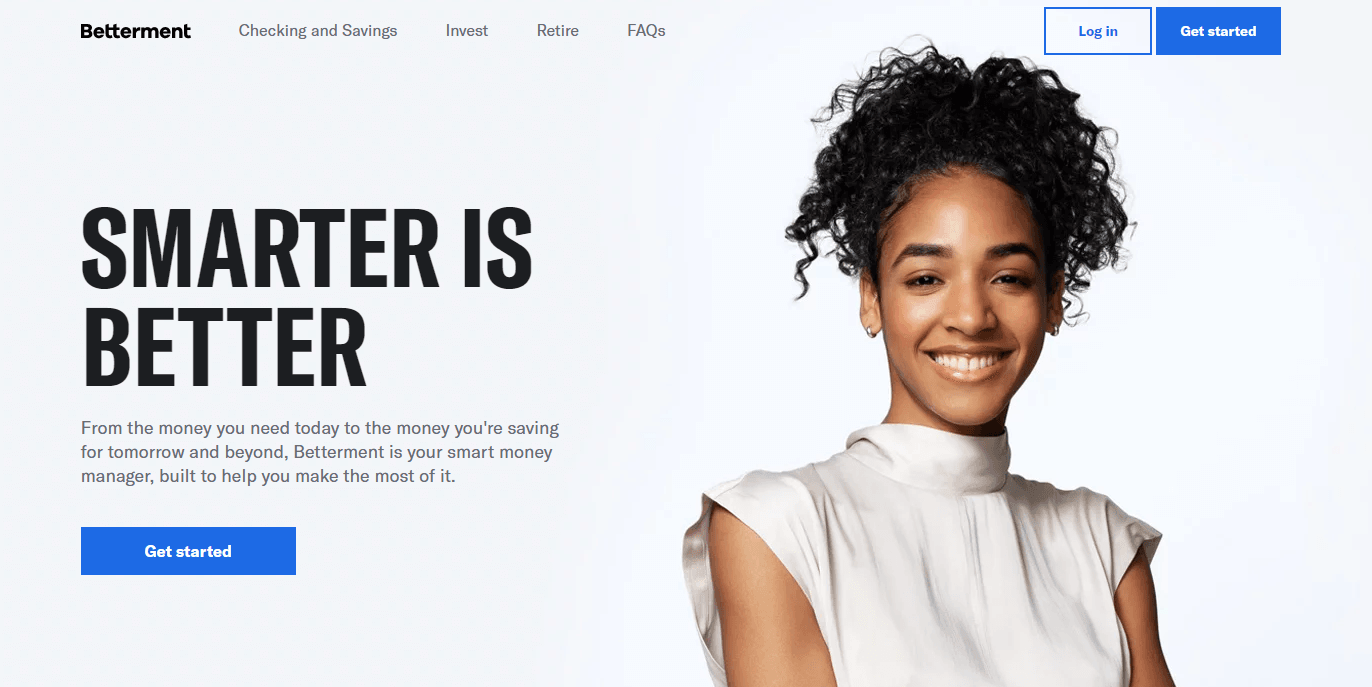
Betterment is a leader in the robo-advisor market. They’re also an excellent choice of micro investing service.
At first glance, you might be overwhelmed by everything they offer.
But don’t worry; Betterment is surprisingly beginner-friendly for having such a wide array of investments and tools.
Betterment offers two plans:
- Betterment Digital (requires no minimum deposit)
- Betterment Premium (requires $100,000 minimum deposit)
The Digital plan is the clear choice here for beginners. It charges a 0.25% management fee, which is quite low among robo-advisors and micro investing services.
Investment Choices
Betterment’s investment offerings are all ETFs. This might disappoint some, but those who are interested in ETF investing will find they have a lot of choices.
Their ETFs are grouped into 4 different portfolios, each with a different strategy. Their main portfolio comes with set weights for each ETF in the portfolio, but you can use their Flexible Portfolio feature to adjust the weights if you want.
Investors can choose a socially responsible portfolio as well. This portfolio only includes companies will good records on social issues such as the environment.
The other two portfolios were constructed by Goldman Sachs and Blackrock. The Goldman Sachs portfolio uses a carefully constructed strategy to outperform a normal market cap focused strategy without sacrificing Betterment’s core portfolio strategy.
The Blackrock portfolio is all bonds. It’s suitable for more conservative investors who want a predictable income stream without exposing themselves to market volatility.
Goal-Based Investing and Tools
Betterment’s all about goals. When you sign up, it asks for you age and annual income. Using this information, it suggests goals for your emergency fund, retirement savings, and general investing.
You can add goals for educational savings and major purchases as well.
Then you get to the tools. One of their tools is called Two-Way Sweep, which operates like Acorns’s round-ups.
Once you link your checking account, Betterment analyzes your spending habits. It’ll then automatically move what it deems to be excess cash and put it in your Betterment account.
You can set a target amount to keep in your linked checking account so Betterment doesn’t overdraw by accident. Also, if Betterment detects your checking is running low, it’ll funnel money back in.
But for even more safety, it’ll alert you every time it’s about to move money around so you can confirm or deny whether you want it to do so.
All in all, Two-Way Sweep makes your micro investing that much easier.
In addition to Two-Way Sweep, Betterment has a tax loss harvesting tool called Tax Loss Harvesting+ (it’ll sell investments at a loss for no extra cost to reap the tax benefits of capital losses) and a retirement tool called RetireGuide (lets you link external retirement accounts, also provides comprehensive retirement planning advice).
Robinhood
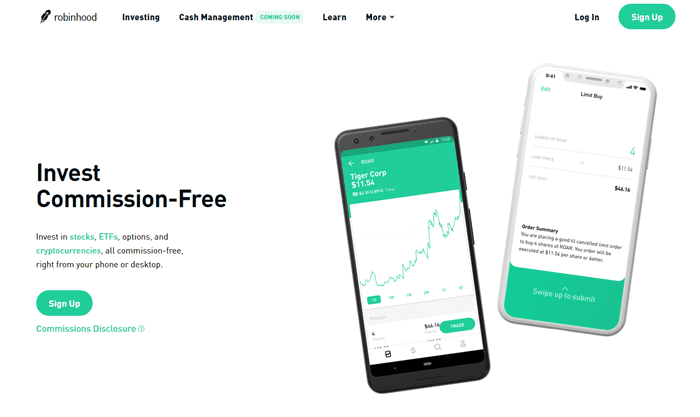
The mythical outlaw Robin Hood stole from the rich and gave it to the poor.
Robinhood doesn’t do any stealing, but it’s similar insofar as it makes investing accessible to those without a lot of money.
It does this by offering $0 fees on stocks, options, ETFs, and even cryptocurrency. Frequent traders and micro investors will reap the biggest savings with Robinhood.
There’s no minimum opening deposit either; you can open an account today even if you’re dead broke.
They have both a website and a mobile app. The mobile app is one of the cleanest we’ve seen so far.
Intuitiveness
Many robo-advisors and online brokers have a lot of extra content tools. While that stuff is great for beginners eager to learn markets and for experienced traders to earn better returns, it can be a little much if you’re just invest and forget.
Robinhood cuts out all the bells and whistles to create a fast and intuitive investing experience. It was built for the smartphone, after all, so they
That becomes apparent the moment you go to sign up. Robinhood first asks for your basic information (personal info, contact info, Social Security number, funding source). They then use instant verification to get your account approved in under an hour, rather than the annoying micro deposit method.
The app compiles everything into 3 screens. One screen displays the performance of assets in your portfolio over several time periods you can choose from. The 2nd screen lets you browse for investments and read financial news, while the 3rd contains information like
- Portfolio balances
- Statements
- Account history
As well as some other useful menus.
Robinhood’s website is also quite simple, but not at the cost of usefulness. They also give you a free stock just for signing up!
Stash
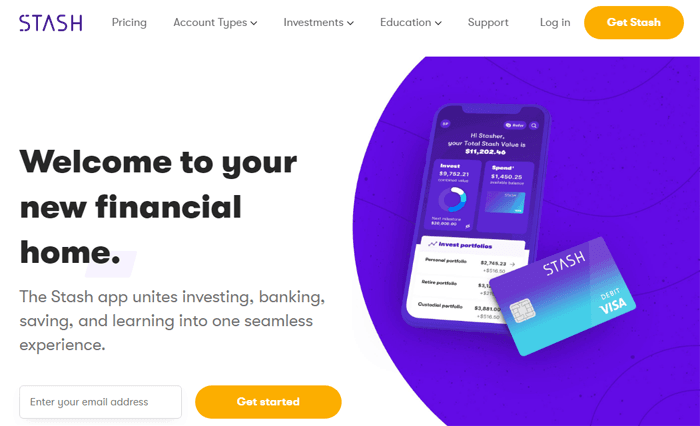
Stash is the micro investing app for beginners who are more serious and want to take their investing a bit more into their own hands while learning the markets. Their investment choices consist of stocks and ETFs; enough to provide diversification, but not so much that it overwhelms new investors.
They do require a $5 minimum opening deposit, which isn’t bad for micro investing apps, but it’s really good for overall investing services.
You don’t need to maintain that $5 balance, though.
As for fees, Stash charges $1/month after your free first month. That doesn’t sound like much, but it’s a huge percentage of your assets if you don’t have a lot built up.
Education and Guidance
Similar to competitors, Stash gathers some information from you to determine suitable goals and risk tolerance. It’ll then suggest ETFs based on your answers.
It’s up to you to build your portfolio based on Stash’s suggestion, but Stash’s Coach feature will guide you by showing you educational content if it notices you aren’t diversifying enough.
Speaking of the Stash Coach, this feature offers the user several categories of challenges meant to teach you healthy investing habits through doing.
Some challenges involve investing in a type of fund, while others might require you to read a short article and learn something.
Completing these challenges earns you points; these points don’t earn you any tangible reward, but they do serve as a way of tracking your intellectual growth as an investor.
Naturally, Stash has a giant library of articles and other content if you want to dive deeper.
Thematic Investing
Are you a huge advocate for the environment? Maybe you’re fascinated by the rising power of cloud technology?
Or maybe you just want an aggressive mix of stocks to take advantage of growth.
Stash renamed its ETFs to more closely reflect their holdings so you can invest on a thematic basis.
For example, the iShares Global Clean Energy ETF was renamed Clean & Green to better illustrate the types of companies in the ETF.
These investments are grouped into the following categories:
- Beliefs – For investors who want to support companies advancing certain causes (this is where Clean & Green would be)
- Balance – ETFs with a variety of assets mixed in for diversification
- Life – Companies that more directly impact your life
- Companies – For if you prefer investing in individual stocks
Stockpile
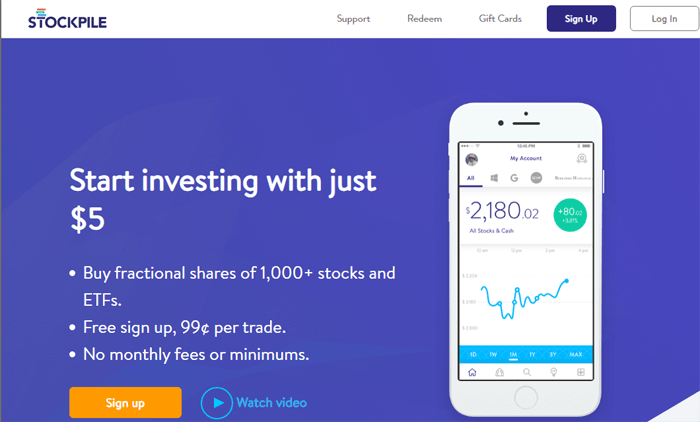
Stockpile, like Robinhood, is an ultra-simple investing app for those who want no frills. They have no account minimums, but they do unfortunately charge $0.99 per trade.
However, that’s not much if you’re an infrequent investors.
As for investment offerings, Stockpile has a range of stocks and ETFs to choose from. In addition, they have some non-US stocks, otherwise known as American Depositary Receipts.
Unlike Robinhood, you can buy fractional shares on Stockpile, making high-priced stocks like Apple accessible to those without a lot of cash.
Kids *Can* Invest On Here
Alright, kids can’t invest on their own on Stockpile. However, parents can open a custodial account for their kids. They can transfer the assets to their kids with this type of account, yet still maintain management/control of the assets until the kid reaches the age of majority.
Parents, this is an inexpensive way to get your child into saving and investing early!
Gift Cards
Stockpile might be one of the first and only investing services that sells gift cards for stocks. You can load these gift cards with up to $2,000 of fractional stock and gift it to someone electronically, in person with a printed paper gift certificate, or through the mail with a real gift card.
Not only can you start your kid investing early, but you now have a fantastic gift idea next time you run out of ideas.
Why not gift someone a small portion of a public company this holiday season?
How to Get Started Micro Investing
Getting started micro investing is easy.
Well, the hardest part is picking which micro investing app you want to use!
But after you pick it, it’s mostly a matter of creating an account, funding your account, and then buying and selling stocks.
That being said, we’ll close our article with some tips to follow while micro investing.
Don’t Check On Your Investments Everyday…
One of investing’s fundamental tenets is to not be emotional. The market is a cold, rational machine; letting your emotions guide your trading decisions could lead to some ill-informed buys or sells, jeopardizing the assets you worked hard to build.
After all, you’re micro investing. You’re not investing life-changing sums of money, but rather, you’re investing the spare change from your grocery trip or the $50 you got for your birthday.
If you absolutely have to know how your investments are doing, try to limit it to once a month to minimize your emotional exposure to the fluctuations of the market.
But Track Your Investments For Tax Purposes
In general, all of your investment decisions will impact your taxes somehow. For example, if you sell a bunch of stock at a gain, you’ll have to report that as capital gains income on your taxes.
Or perhaps you own dividend-paying stock and you earn $20 in dividends. Dividend income must also be reported.
Most micro investing apps will send you the proper tax forms so you can report everything accurately on your taxes. For further help, many let you export your transaction history so you know exactly how much gain or loss you made over the year.














































